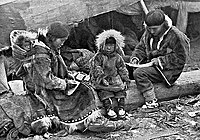
Photo from wikipedia
Integrations of cognitive models of depression, specifically, the hopelessness model (Abramson et al. Psychological Bulletin, 96, 358–372, 1989) and the response style theory (Nolen-Hoecksema et al. Journal of Abnormal Psychology,… Click to show full abstract
Integrations of cognitive models of depression, specifically, the hopelessness model (Abramson et al. Psychological Bulletin, 96, 358–372, 1989) and the response style theory (Nolen-Hoecksema et al. Journal of Abnormal Psychology, 101, 405–422, 1992) have been suggested but no previous study has compared the integrations of these models with each other and the original models. Further, previous studies only tested the associations between composite scores of inferences, from the hopelessness model, and rumination (incl. brooding and reflection), from the response style theory. Thus, a 3-wave study using self-report instruments with 519 adolescents was conducted (mean ageWave 1 = 16.09 years; SD = 0.70; 62.7% female; 72.8% European American, 14.7% African-American, 5.4% Latino, 4.4% mixed race/ethnicity, 1.4% Asian/Pacific Islander, 0.8% Native American, and 0.6% identified as “other”). The school serves predominantly working to middle class families and almost one third of the students were eligible for free or reduced lunch programs. AMOS and RMediation were used to calculate and compare five different theory-driven models. The findings of the study provide support for an integrated model in which both brooding and reflection are influenced by individual inferences and interact with individual inferences while affecting depressive symptoms. In addition, reflection plays an unexpectedly important role in this integrated model. Age and cognitive development are discussed as possible explanations for this finding.
Journal Title: Journal of Abnormal Child Psychology
Year Published: 2019
Link to full text (if available)
Share on Social Media: Sign Up to like & get
recommendations!